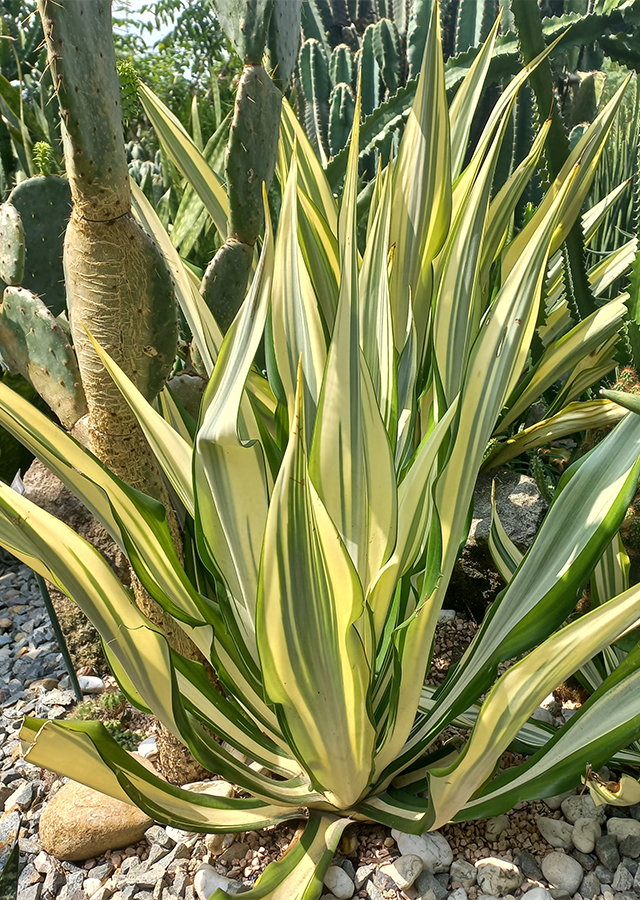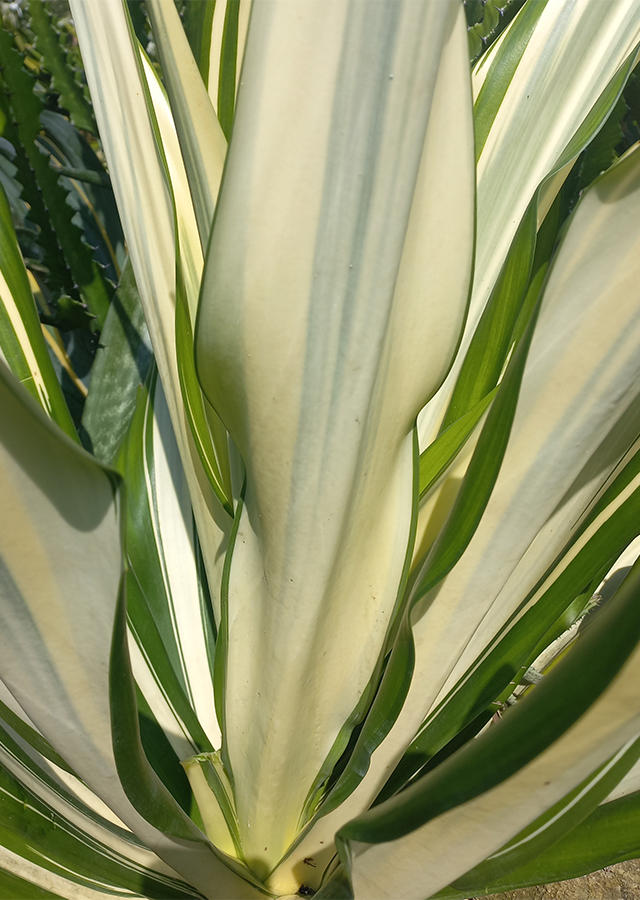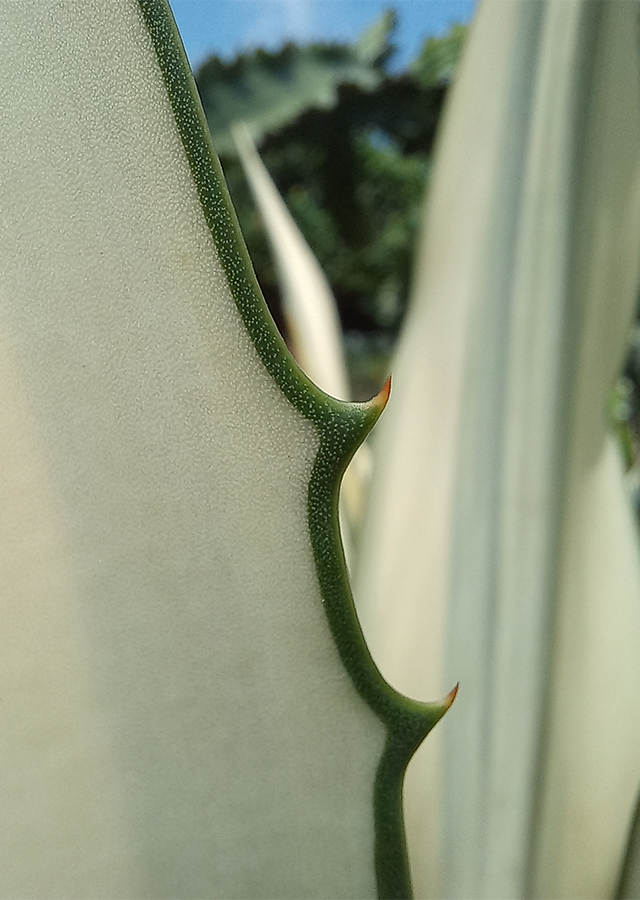Mauritius Hemp
Furcraea foetida (L.) Haw.
Asparagaceae
Location in our garden
Principal



Synonym
Agave foetida L.
Agave gigantea (Vent.) D.Dietr.
Furcraea gigantea Vent.
Habitus
Succulent. An evergreen succulent perennial plant that grows up to 2 m tall.
Part Used
Leaves
Roots
Sap
Growing Requirements
Full Sunshine
Drought Resistant
Habitat
Forest
Coastal
Rocky Areas
Shrublands
Terrestrial
Overview
Furcraea foetida is native to tropical America and its natural distribution extends from southern Mexico to the northern and eastern coast of South America and the south-eastern Antilles. It is widely planted and naturalized throughout the tropics. It has been grown commercially as a fibre plant in many regions, including India, Venezuela, Brazil, and St. Helena, and in Africa in Madagascar, Mauritius and South Africa. It is used as animal food, a poison (fish poison) and a medicine, has environmental uses (to prevent erosion) and for fuel and food. It is widely planted as an ornamental plant in gardens, especially variegated varieties.
Vernacular Names
Cáñamo de Mauritania (Spanish), Chanvre de Maurice (French), Cânhamo-da-mauritânia (Portuguese), Henequén de Haiti (Cuba), Gheequar (India), Agao to (Vietnamese).
Agroecology
A plant of the tropics. It grows best in areas where annual daytime temperatures are within the range 23-30 °C, but can tolerate 16-34 °C. It prefers a mean annual rainfall in the range 1,000-2,100 mm, but tolerates 700-2,500 mm. Requires a well-drained, medium to light soil and a sunny position. Prefers a pH in the range 6-7, tolerating 5.5-8. Generally grows best in a well-drained, medium to light soil, but can tolerate a wide range, including heavy clay soils. It is also very drought tolerant. Furcraea foetida is resistant to salt spray, short droughts, and temperatures down to –4 °C or even –7 °C.
Morphology
- Root - lateral roots.
- Stem - short thick stem, bearing about 50 densely crowded leaves in a rosette.
- Leaves - bright green, rigid, straight or curved, up to 2-2.5 m long, 14-20 cm wide, with a few widely spaced marginal prickles, especially toward base; these are 4-10 mm long, apex with a short blunt spine.
- Flower - inflorescence a terminal panicle 6–13 m long (including peduncle); branches dividing several times; peduncle up to 10 m long. Flowers bisexual, pendulous, 4 cm long, greenish-white outside, white inside, fragrant; pedicel 5–10 mm long.
- Fruit - an ellipsoid-trigonous capsule, loculicidally 3-valved, with numerous but rarely produced seeds.
- Seeds - flat, black.
Cultivation
Furcraea foetida is propagated from bulbils, which root and grow into new plants when they fall to the ground.
Chemical Constituents
Tannins, phenolic compounds, saponins (furcreastatin, hecogenin), flavanoids and phytosterols.
Traditional Medicinal Uses
- In Brazil, root decoctions are taken as a diuretic and against venereal diseases, slightly roasted leaf sections are applied on swellings and tumours, and the sap of roasted leaves is applied on ulcers and wounds.
- In Puerto Rico, extracts from the roots are used as a blood-purifying tonic, and dried leaves are used to control swelling and to promote wound healing.
- Roots infusion with sweet oil is drunk as a treatment for syphilis. The root is mixed with gin and used as a treatment for back pain.
- The leaf sap is applied on purulent wounds, and used on the hair to make it glossy and to prevent hairs from falling out.
- A leaf decoction is externally applied for the treatment of rheumatism and paralysis, and an alcoholic extract of the leaf is recommended as a diuretic in case of oedema.
Part Used
Reference Sources
- Buddenhagen, C.E. (2013). Furcraea foetida (Mauritius hemp). https://www.cabi.org/isc/datasheet/114444#toPictures. 03-04-2022.
- Fern, Ken. (2021). Useful Tropical Plants: Furcraea foetida. https://tropical.theferns.info/viewtropical.php?id=Furcraea+foetida. 03-04-2022.
- Kew Royal Botanic Gardens. (No date). Plants of the world Online: Furcraea foetida (L.) Haw.. https://powo.science.kew.org/taxon/urn:lsid:ipni.org:names:64429-1. 03-04-2022.
- Mathew, J., et al. (2012). Evaluation of phytochemical composition and antioxidant activity of aqueous extract of Barleria mysorensis and Furcraea foetida leaves. Research Journal of Pharmacy and Technology, Vol.5 (12).
- Vaughan, G. (2015). Furcraea foetida (PROTA). https://uses.plantnet-project.org/en/Furcraea_foetida_(PROTA). 03-04-2022.


